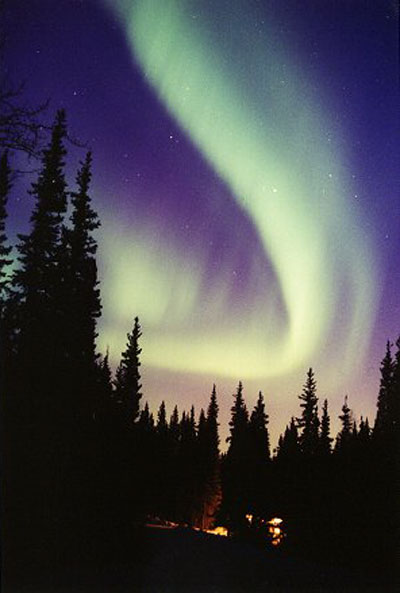Explanation: Early April brought some of the most intense auroral storms this decade. An aurora on April 6 was reported to be the largest visible on Earth since 1989, and was seen throughout Europe and much of northern North America. On that day, many skywatchers expecting to see a rare alignment of planets were treated to a additional treat. Many reported aurorae with a relatively unusual red color. The above aurora recorded at dusk over Alaska sported the more typical green glow. A huge auroral ring can be seen superposed above trees and a building. Auroral activity occurs high in the Earth's atmosphere and is a direct result of storms on our Sun. As huge sheets of charged particles stream out from the Sun, a small fraction of these particles are funneled in by Earth's magnetic field and strike atoms high in the atmosphere, causing the sky to glow. The particles are harmless to people on Earth's surface, but can cause havoc on satellites in orbit far above.
1999 2000 2001 2002 2003 2004 2005 2006 2007 2008 2009 2010 2011 2012 2013 2014 2015 2016 2017 2018 2019 2020 2021 2022 2023 2024 2025 |
Yanvar' Fevral' Mart Aprel' Mai Iyun' Iyul' Avgust Sentyabr' Oktyabr' Noyabr' Dekabr' |
NASA Web Site Statements, Warnings, and Disclaimers
NASA Official: Jay Norris. Specific rights apply.
A service of: LHEA at NASA / GSFC
& Michigan Tech. U.
|
Publikacii s klyuchevymi slovami:
aurora - storm - Earth's atmosphere - polyarnoe siyanie - Solnechnaya aktivnost' - Magnitnoe pole Zemli
Publikacii so slovami: aurora - storm - Earth's atmosphere - polyarnoe siyanie - Solnechnaya aktivnost' - Magnitnoe pole Zemli | |
Sm. takzhe:
Vse publikacii na tu zhe temu >> | |
